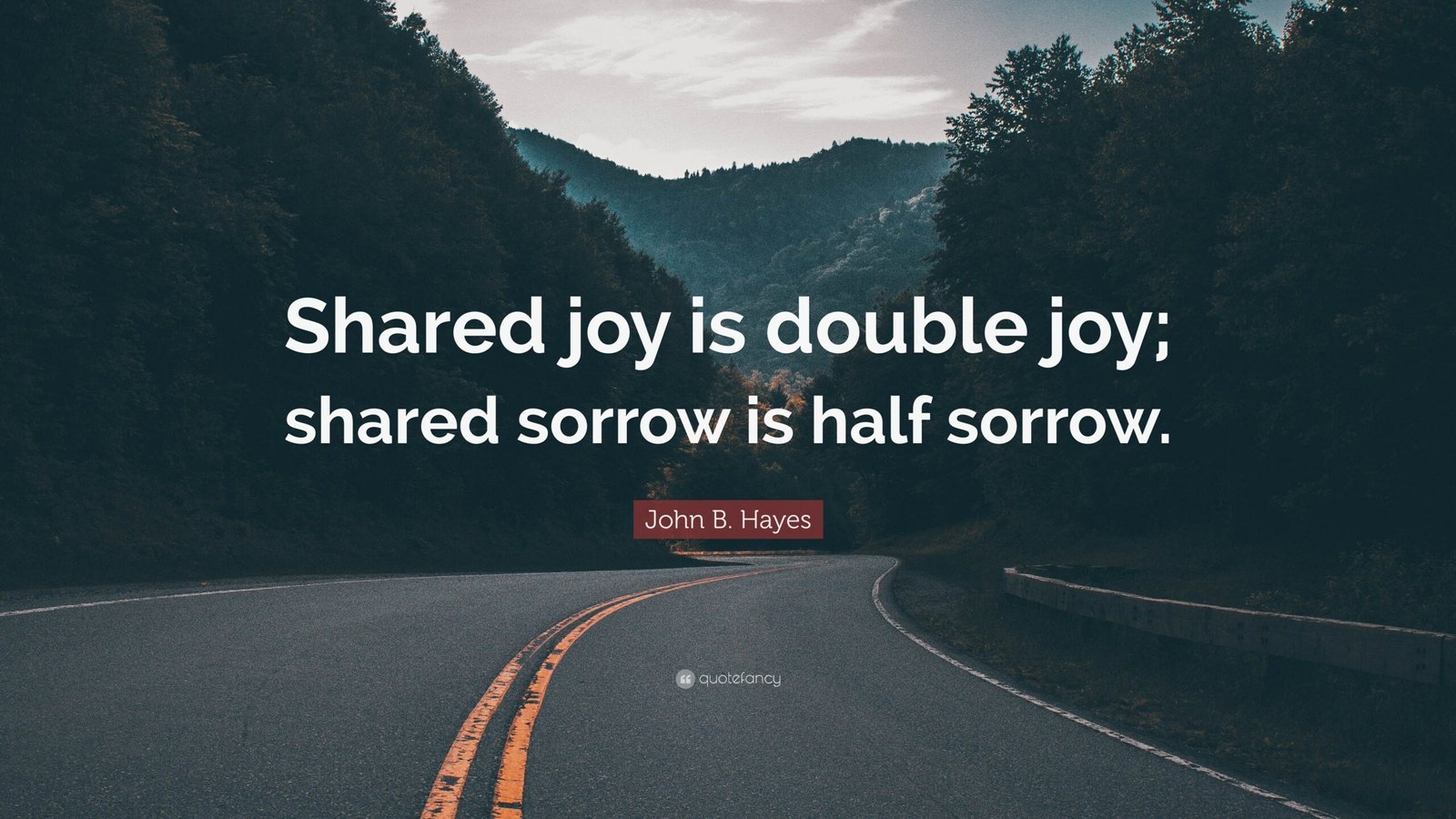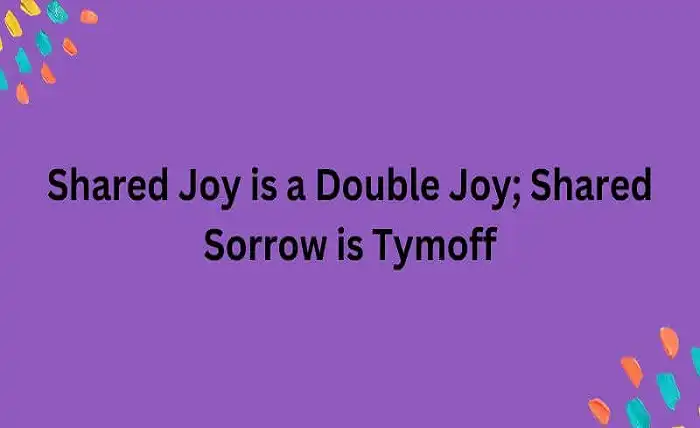
Introduction:
shared joy is a double joy; shared sorrow is tymoff, In the intricate tapestry of human emotions, one profound truth stands out: the power of sharing experiences. The saying, “Shared joy is a double joy; shared sorrow is half sorrow,” encapsulates this idea eloquently. At its core, this adage highlights the transformative effect of human connection on both happiness and suffering. In this article, we delve into the origins, meaning, and implications of this timeless wisdom, exploring how sharing emotions enhances our lives and deepens our relationships.

Origins and Cultural Significance:
The roots of this proverb can be traced back to various cultural traditions and philosophical schools of thought. While its exact origin remains elusive, its essence resonates across cultures and epochs. In essence, it reflects a fundamental aspect of human nature: our innate desire for companionship and empathy.
Must Read=c.w. park usc lawsuit
Throughout history, diverse civilizations have recognized the value of shared experiences in amplifying joy and alleviating sorrow. In Chinese culture, the concept finds expression in the proverb, “Happiness shared is doubled; sorrow shared is halved.” Similarly, in African traditions, communal rituals and storytelling serve as vehicles for collective celebration and solace in times of hardship.
Philosophical Insights:
From a philosophical perspective, this adage embodies the principles of altruism, empathy, and interconnectedness. Philosophers and thinkers across traditions have explored the significance of shared emotions in shaping human relationships and well-being.
Aristotle, in his Nicomachean Ethics, emphasizes the importance of friendship in the pursuit of eudaimonia, or human flourishing. According to Aristotle, true friendship involves sharing in each other’s joys and sorrows, thereby enriching one’s own life. Similarly, in Eastern philosophies such as Buddhism and Confucianism, compassion and mutual support are central tenets for achieving harmony and fulfillment.
Psychological Insights:
Modern psychology corroborates the wisdom embedded in this proverb, shedding light on the psychological mechanisms underlying the shared experience of emotions. Research in social psychology and neuroscience has demonstrated the profound impact of social bonds on emotional well-being.
Studies have shown that sharing positive experiences with others not only enhances enjoyment but also strengthens social bonds and fosters a sense of belonging. Conversely, during times of adversity, the presence of empathetic companions can mitigate the intensity of suffering and facilitate coping mechanisms.

Moreover, the phenomenon of emotional contagion highlights how individuals can “catch” emotions from those around them, amplifying both positive and negative affect. This contagion effect underscores the interconnected nature of human emotions and the importance of surrounding ourselves with supportive social networks.
Real-Life Examples:
Countless examples from literature, history, and everyday life illustrate the transformative power of shared emotions. From the camaraderie forged among soldiers on the battlefield to the solidarity displayed during times of crisis, human beings have demonstrated an innate capacity for empathy and compassion.
In literature, timeless classics such as Victor Hugo’s “Les Misérables” and Harper Lee’s “To Kill a Mockingbird” depict characters who find solace and strength through their connections with others. These narratives resonate with readers because they reflect universal truths about the human experience and the significance of shared emotions in navigating life’s challenges.
In contemporary society, the rise of social media has facilitated new forms of communal expression, enabling individuals to share their joys and sorrows with a global audience. From viral videos of heartwarming acts of kindness to online support groups for those facing adversity, digital platforms have become virtual spaces for collective emotional engagement.
Implications for Relationships:
At its heart, the saying “Shared joy is a double joy; shared sorrow is half sorrow” speaks to the profound impact of emotional intimacy on relationships. Whether in friendships, romantic partnerships, or familial bonds, the ability to empathize and connect with others lies at the core of meaningful human connections.
In romantic relationships, couples who share both their triumphs and tribulations foster a deeper sense of intimacy and mutual support. By celebrating each other’s successes and weathering challenges together, partners cultivate resilience and strengthen their bond over time.
Similarly, in friendships, the willingness to listen, empathize, and offer support during difficult times solidifies trust and loyalty. True friends stand by each other through thick and thin, sharing in the joys of achievements and providing comfort in moments of despair.

FAQ
- What does the phrase “Shared joy is a double joy; shared sorrow is half sorrow” mean?This phrase emphasizes the idea that sharing joyous experiences with others amplifies the happiness felt, while sharing sorrows diminishes the pain experienced.
- Where does this saying originate from?While the exact origin is uncertain, variations of this adage can be found across different cultures and historical periods, suggesting its universal appeal.
- Why is shared joy considered a double joy?Shared joy is considered double because when we share our happiness with others, it not only magnifies our own joy but also enhances the joy of those with whom we share the experience.
- How does sharing joy contribute to personal well-being?Sharing joy fosters a sense of connection and belonging, leading to increased happiness and fulfillment. It also strengthens relationships and creates positive memories.
- What does “shared sorrow is half sorrow” imply?This part of the phrase suggests that when we share our sorrows with others, the burden feels lighter, as we receive comfort and support from those who empathize with our struggles.
- How does sharing sorrow lessen its impact?Sharing sorrow allows individuals to feel understood and supported, reducing feelings of isolation and despair. It also provides an opportunity for emotional processing and healing.
- Can sharing joy and sorrow with others strengthen relationships?Yes, sharing both joy and sorrow fosters deeper emotional bonds and mutual understanding, enhancing the quality of relationships.
- What role does empathy play in the experience of shared joy and sorrow?Empathy enables individuals to resonate with the emotions of others, facilitating meaningful connections and effective support during both joyful and challenging times.
- Is it necessary to share every joy and sorrow with others?While sharing experiences can be beneficial, individuals have different preferences for privacy and self-expression. It’s important to respect personal boundaries and choose confidants wisely.
- How can one support others in times of sorrow?Offering a listening ear, expressing empathy, and providing practical assistance are effective ways to support someone experiencing sorrow.
- What are some ways to share joy with others?Celebrating achievements together, expressing gratitude, and engaging in enjoyable activities as a group are all ways to share joy with others.
- Does sharing joy and sorrow require vulnerability?Yes, sharing emotions with others often involves vulnerability, as it requires opening up and being honest about one’s feelings.
- Can sharing joy and sorrow lead to emotional intimacy?Yes, sharing both positive and negative experiences fosters emotional intimacy by deepening mutual trust and understanding.
- Are there cultural differences in how joy and sorrow are shared?Yes, cultural norms and values influence how individuals express and share emotions. For example, some cultures may prioritize collective celebrations, while others emphasize stoicism in times of adversity.
- What are the benefits of sharing joy and sorrow within a community?Sharing experiences within a community strengthens social bonds, promotes empathy and compassion, and creates a supportive environment for collective growth and resilience.
- Can sharing joy and sorrow contribute to personal growth?Yes, sharing both positive and negative experiences allows individuals to learn from each other, develop empathy, and cultivate emotional resilience.
- How does social media influence the sharing of joy and sorrow?Social media platforms provide a virtual space for sharing experiences with a wider audience, but they may also present challenges related to authenticity and privacy.
- What should one do if they find it difficult to share their emotions with others?Seeking support from trusted friends, family members, or mental health professionals can help individuals navigate the process of sharing their emotions.
- Are there times when it’s inappropriate to share joy or sorrow with others?It’s important to consider the context and the preferences of those involved. In certain situations, such as during someone else’s moment of grief, it may be more appropriate to offer silent support rather than sharing personal experiences.
- How can practicing empathy enhance the experience of shared joy and sorrow?By putting oneself in the shoes of others and understanding their perspectives, individuals can offer more genuine support and forge deeper connections during both joyful and challenging times.
Conclusion:
In conclusion, the saying “Shared joy is a double joy; shared sorrow is half sorrow” encapsulates the profound truth that human emotions are inherently relational. Through empathy, compassion, and shared experiences, we amplify the highs and mitigate the lows of life’s journey. Across cultures, philosophies, and disciplines, this timeless wisdom reminds us of the transformative power of human connection in shaping our well-being and enriching our lives. As we navigate the complexities of existence, let us cherish the bonds that unite us and embrace the beauty of shared emotions in all their depth and complexity.



